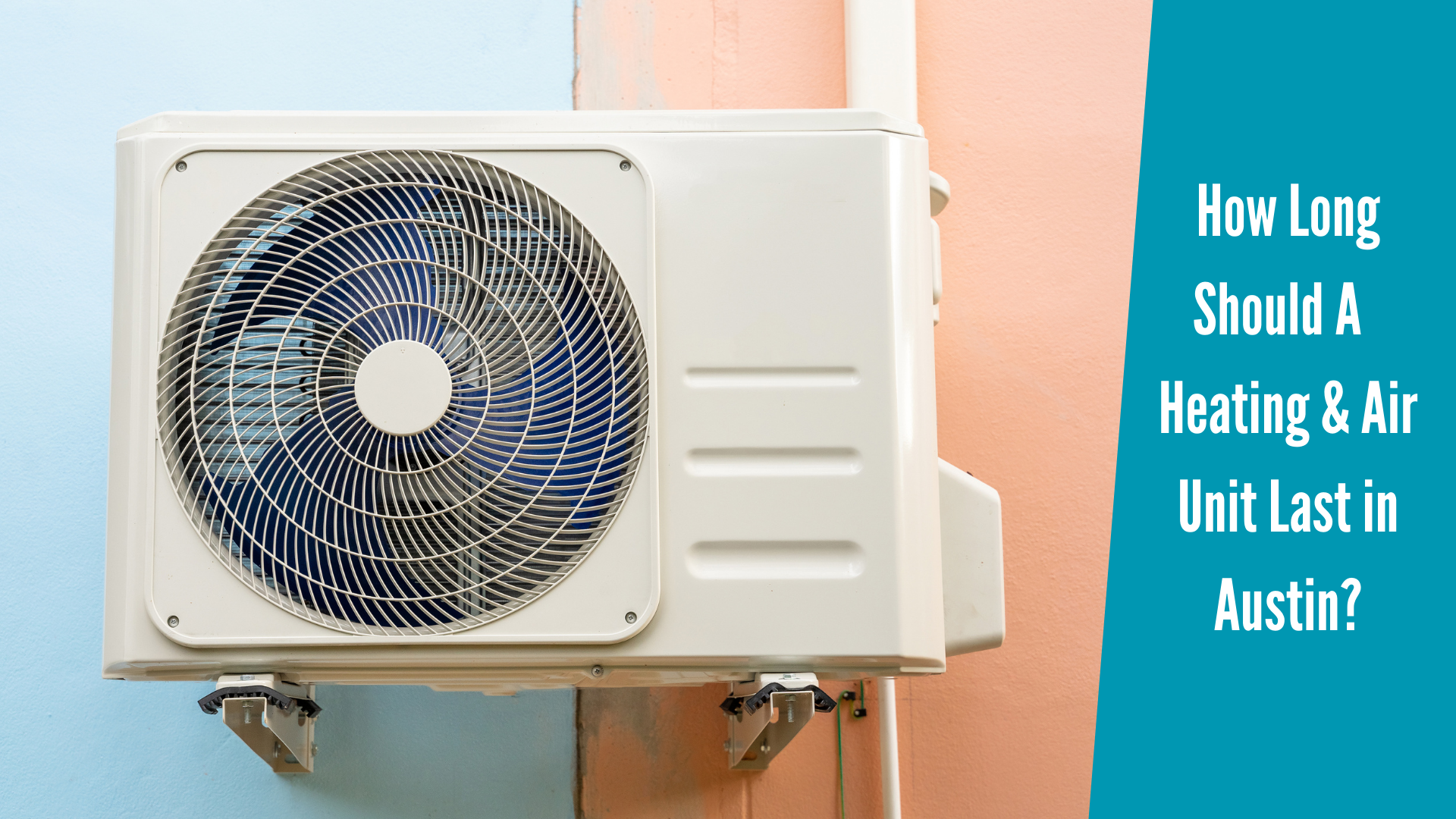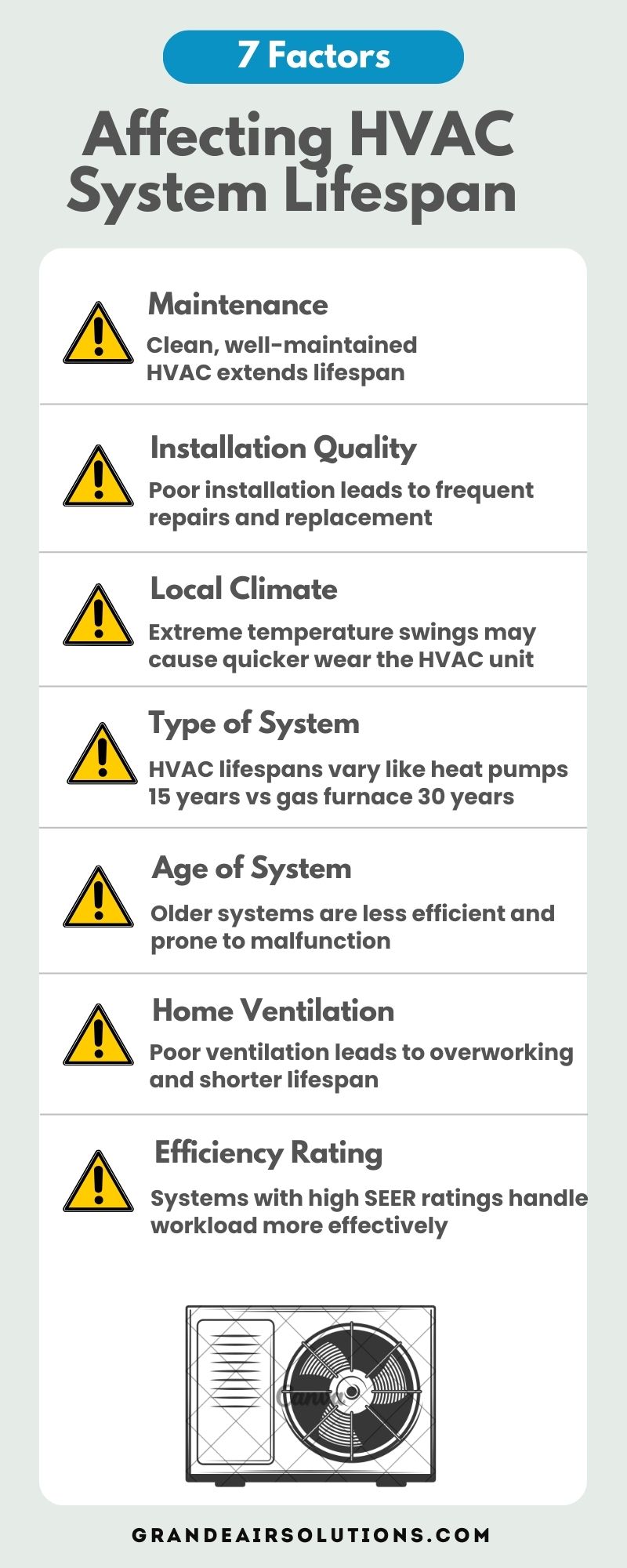
It's a blistering summer day in Austin, and you're seeking refuge in the cool confines of your home. The hero of the day? Your trusty Austin heating and air unit works tirelessly to maintain a comfortable temperature. But how long should this unsung hero last in the heart of Texas? And more importantly, how can you extend its lifespan, thus ensuring a cool oasis amid the Austin heat waves?
The lifespan of a heating and air unit in Austin is like a delicate dance, where climatic conditions and maintenance routines play the lead roles. Typically, these units have a longevity of 10 to 25 years, but this can vary based on your unit type.
Our team, Grande Austin HVAC TX, has done all the research for you, so go through this guide and find the exact lifespan for your specific unit and how you can ensure it lives a long, fulfilling life.

Proper maintenance is like the lifeblood of an HVAC system. Regular servicing ensures the smooth running of the system, just like frequent oil changes keep a car engine purring. A clean, well-looked-after HVAC is less likely to break down, extending its lifespan. Energy Star says an HVAC should be serviced at least once a year for optimal performance.
Quality of installation plays a pivotal role in determining the lifespan of an HVAC system. It's similar to laying a solid foundation for a house; without it, the whole structure is at risk. A poorly installed HVAC system can lead to frequent repairs and early replacement. Therefore, always choose a professional service like Austin Heating And Air for your HVAC installation needs.
Mother Nature holds a significant influence over the longevity of your HVAC system. For instance, Austin HVAC TX systems usually last longer than those in coastal areas, where salt can corrode the components. Similarly, HVAC systems might have to work harder in regions with extreme temperature swings, resulting in quicker wear and tear.
Different breeds of dogs have varied lifespans, and various HVAC systems have varying lifespans, too. Some systems, like heat pumps, have a lifespan of around 20-25 years, while others, like gas furnaces, can last for 15-20 years.
The age of the system is a clear-cut factor. An older system, like a favorite pair of shoes, may eventually wear out and need replacement. As an HVAC system ages, its efficiency decreases, and the likelihood of malfunctioning increases.
The level of usage is another significant factor. An HVAC system constantly running is like a marathon runner without rest. Overuse can cause faster wear and tear and a shorter lifespan. To maximize the life of your system, ensure it's not working harder than necessary.
Good home ventilation is like giving your HVAC a helping hand. It reduces the burden on the system, allowing it to work less and last longer. Poorly ventilated homes may cause an HVAC system to overwork, leading to a shorter lifespan.
An HVAC system's efficiency rating is like a car's fuel efficiency. Higher ratings mean the system is designed to work more efficiently, often leading to a longer lifespan. HVAC systems having a high Seasonal Energy Efficiency Ratio (SEER) rating tend to last longer because they handle workload more effectively.
Austin's climate can be brutal on your heating and air units, with sweltering summers and frigid winters, not to mention the sudden weather changes Austin is notorious for. The life expectancy of your HVAC systems can be significantly influenced by these factors, along with the quality of the units and how well they're maintained.
Your typical window unit AC in Austin might last 10 to 15 years. These handy devices are subjected to a lot of wear and tear due to Austin's hot summers. However, you can extend their lifespan with regular cleaning and preventive maintenance.
A residential single whole-home unit is designed to be more robust and efficient, typically lasting between 15 to 20 years. Although the initial cost of installation might be higher compared to other units, the extended lifespan and lower energy consumption make it a worthwhile investment.
Heat pumps in Austin's atmosphere can last from 10 to 15 years. However, good maintenance can extend their lifespan to 20-25 years. Preventative maintenance can improve efficiency and prevent breakdowns, prolonging these units' life.
Gas furnaces typically last much longer than oil furnaces, ranging from 20 to 30 years. Oil furnaces, on the other hand, tend to have a shorter lifespan of 10-15 years due to the corrosive nature of the fuel.
Steam boilers are known for longevity and can last from 15 years to 35 years, depending on the model and how well they are maintained. Regular inspections and timely repairs are critical to extending the lifespan of these units.
Radiant heaters in Austin can last between 15-20 years. These heaters use infrared technology to heat a room, making them more efficient and longer-lasting than traditional heaters.
Ductless mini-splits have a broad lifespan range, from 10 to 30 years, mainly depending on the model and how well they are maintained. Choosing a high-quality model and ensuring regular maintenance are vital to prolonging their lifespan.
Thermostats typically last about 10 years. While they may not directly contribute to heating or cooling your space, they play a crucial role in controlling your Austin Heating and Air system, and maintaining them can significantly impact the efficiency of your overall HVAC system.
| HVAC Unit | Lifespan | Austin's Climate Impact |
| Window Unit AC | 10-15 years | Hot summers in Austin can increase wear and tear, so regular maintenance is essential for a longer lifespan. |
| Whole-Home Unit | 15-20 years | Austin's hot climate can make these units work harder, but their efficiency and durability help them withstand the weather conditions. |
| Heat Pumps | 10-15 years (20-25 years with maintenance) | Hot weather may increase usage, so proper maintenance is essential for longevity. |
| Gas Furnaces | 20-30 years | Austin's hot climate puts less strain on furnaces, allowing gas furnaces to reach the upper end of their lifespan range. |
| Oil Furnaces | 10-15 years | The corrosive nature of oil fuel can reduce their lifespan, and hot weather may have a limited impact. |
| Steam Boilers | 15-35 years | Regular inspections and maintenance are essential to maximize the lifespan, as hot weather may accelerate wear. |
| Radiant Heaters | 15-20 years | Austin's climate doesn't significantly impact their lifespan; they remain efficient even in the heat. |
| Ductless Mini-Splits | 10-30 years | Hot weather can increase usage, so maintenance is crucial for longer lifespans. |
| Thermostats | About 10 years | Austin's hot climate can lead to more frequent HVAC system use, making thermostat maintenance crucial for system efficiency. |
Please note that the actual lifespan of these units can vary based on factors like brand, quality, maintenance, and usage patterns. The ranges provided are typical estimates and can serve as general guidelines.
Neglecting your HVAC system may result in poor cooling capacity, frequent repairs, and soaring energy bills. If you are in any of these situations, contact Grande Air Solutions - your trusted Austin Heating and Air company. We strive to breathe new life into your HVAC system, ensuring it performs optimally.
While a well-installed Austin heating and air unit is crucial, it's only part of the longevity equation. Regular maintenance and servicing are equally vital. We often advise our customers to maintain their air conditioners diligently. This includes changing filters every 3 to 6 months and scheduling yearly tune-ups.
With proper and frequent maintenance, your HVAC system will serve you reliably and efficiently. Here are the perks you stand to enjoy:
Grande Air Solutions recommends annual maintenance for all your Austin HVAC TX needs, including an all-encompassing inspection, coil cleaning, and filter replacements. Reach out to our team to learn more about our maintenance plan and the benefits that come with it.
